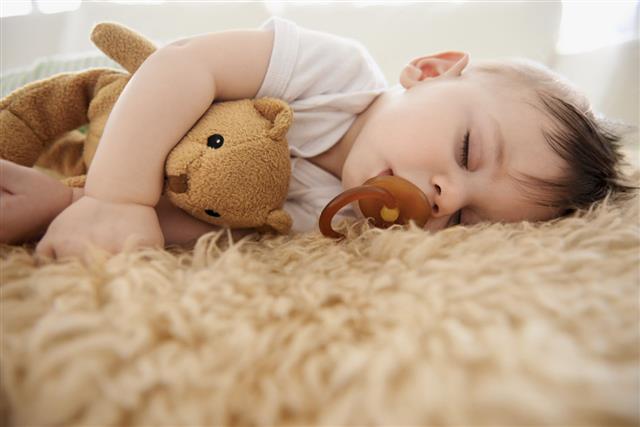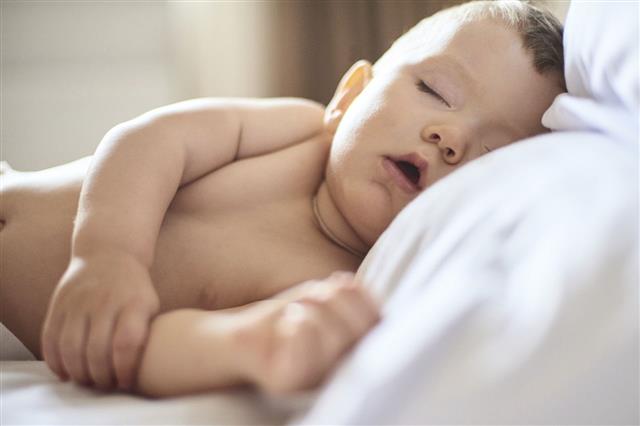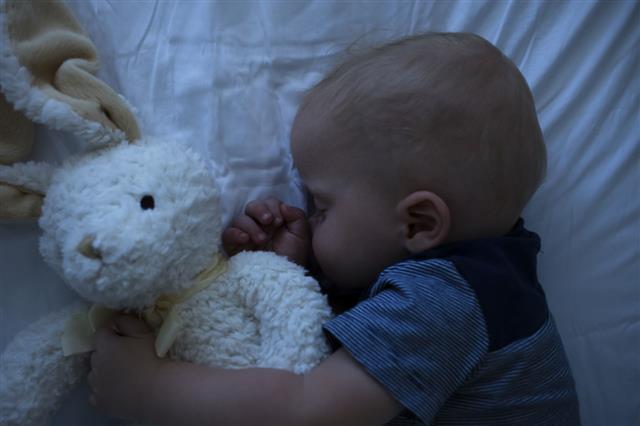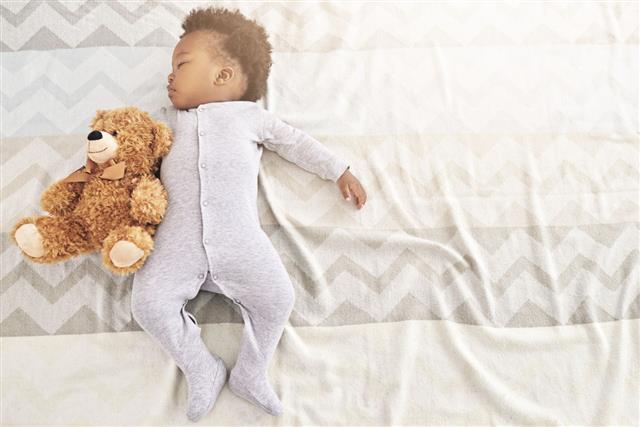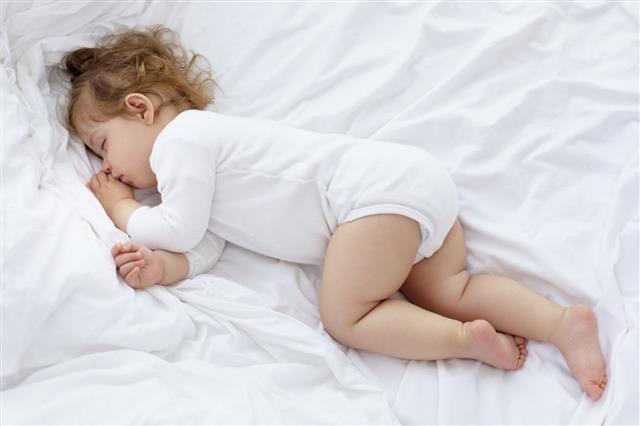
Sleep disorders in toddlers can be very horrible for them, as well as disturbing for the whole family. Fortunately, they are all treatable and go away with time. Here are a few reasons that lead to these disorders and some techniques to deal with them.
‘Sleeping like a baby’ is synonymous with sleeping soundly and without worries. But do babies always sleep as soundly as we think they do? Babies, too, may sometimes have disruptive sleeping patterns. Sleep disorders in toddlers, although differing in severity, are very common. If your toddler often wakes up in the night, screaming or crying, terrified or shocked, is clueless/confused about his surroundings or seems disoriented every time that he wakes up at night, he may be suffering from a sleep disorder. Sleep disorders in toddlers require different treatments and treatment methods as compared to adults. The two main causes of sleep disorders in toddlers are:
- Faulty/Defective Genes
- An immature Nervous System
These are generally detected by observing abnormalities in Polysomnography or PSG tests conducted on the toddler.
Snoring
Although snoring is often dismissed as a harmless condition, it is far from being that. Even though snoring itself is not harmful, it is an indicator that something is wrong which needs to be addressed. Most times, snoring occurs when toddlers are suffering from a common cold, in which case it is not cause for alarm. But if your toddler is snoring on a regular basis, it could indicate an underlying problem. Snoring could be an indication of a respiratory problem, excessive mucus formation leading to blocked noses causing snoring, OSAS (obstructive sleep apnea syndrome), blockages in the respiratory tract, etc. Hence, the sooner it is treated the better.
Night Terrors
Night terrors are also known as pavor nocturnus. These are episodic in nature and occur 90 minutes into sleep. This condition makes the child wake up in the middle of the night and sit bolt upright, due to terror. The child may cry inconsolably for a long time before falling asleep again. You may also observe signs of tachycardia or tachypnea to a certain extent. Night terrors occur between the ages of 3-8. They usually arise from stress or fatigue, which needs to eliminated by careful observation of the child’s environment. Night terrors are different from nightmares, and the two should not be confused.
Head Banging and Rocking
Head banging usually makes an appearance around the 1 year mark, and is usually at its worst between the 1st and 2nd years. Although a little head banging/rocking at night is not really unusual and alarming, if it persists for several months without showing any signs of letting up, or if it seen during the day as well, then it needs to be checked out. If it happens only at night, the chances are that your toddler is just soothing himself to sleep. Head banging can be a rhythmic activity that the child requires to help him get to sleep. The ‘rocking’ motion is comforting for him, and makes him feel safe and secure. To prevent toddlers from head banging, try rocking them more before putting them in bed, singing lullabies, rubbing their backs soothingly, and playing calm and soft music in their room while they are trying to sleep. If after doing this for a few weeks, the head banging/rocking doesn’t reduce, consult the doctor.
Sleepwalking and Sleeptalking
Sleepwalking (somnambulism) and sleeptalking (somniloquy) is more frequently seen in boys than in girls. Such disorders make the child sit up in bed with his eyes wide open. Although his eyes are open, the child cannot see. Speech is mumbled and slurred. Sleepwalkers face physical threats, like walking into doors and pillars or falling down a flight of stairs. While intervening with sleepwalkers, parents should refrain from shaking or slapping the child to bring him into a state of consciousness. Maintain a diary of the time your child wakes up, what he/she talks and how long the episode lasts, and then consult a doctor. Once you have an established time, try waking up your child 10 – 15 minutes prior to it, and make him stay awake for sometime.
Bedwetting
Bedwetting is also known as nocturnal enuresis. It is a very common problem in toddlers. It is classified into two types:
- Primary Enuresis: This is when your child has never had a “dry spell”, and has been bedwetting since infancy. Primary enuresis may have its root in the family history.
- Secondary Enuresis: This is when your child has gone through a “dry spell” and has started bedwetting again after having stopped it completely. Secondary enuresis is usually caused due to developmental problems.
Nocturnal sleep enuresis can be solved by making the child use the bathroom before the parents go to bed or limiting fluid intake before sleeping. Alternately, you can also try waking your child up a couple of times at night to make him go to the toilet, so that he has no reason to wet the bed.
Bedwetting is generally caused due to stress or emotional distress. Try figuring out if your child is having any problems, and try to eliminate these problems. If bedwetting still persists by age 10, it is time to go to the doctor.
Sleep Apnea
Obstructive sleep apnea affects 1-3% children. Sleep apnea can be very harmful and potentially fatal if not detected and treated on time. Snoring, breathing through mouth and difficulty in breathing are some of the symptoms of sleep apnea. Enlarged tonsils or adenoids are the main causes of sleep apnea in toddlers. While the child is sleeping at night, the airways may get temporarily blocked, preventing air from reaching the lungs, resulting in mouth-breathing, gasping, and chocking. Allergies can also trigger sleep apnea in children. Sleep apnea in toddlers may lead to problems in growth, learning and behavior. Removal of tonsils/adenoids will provide your child relief from sleep apnea. The other way of dealing with sleep apnea in toddlers is to use continuous positive airway pressure machine or CPAP, which is a type of mask. This mask allows the airway to open up to bring about normal rhythm of breathing. It is very important that this condition be brought to the attention of the doctor immediately.
Secondary Sleep Disturbances
Secondary sleep disturbances are more common in toddlers than the above listed sleep disorders. Some frequently seen examples are:
- Night awakenings
- Grinding of teeth
- Bedtime resistance/Restlessness
- Unusual/Uncomfortable sleeping positions
- Cycling/Twitching/Jerking during sleep
- Night sweats
Most newborn babies cry if they wake up during the night and find comfort only after a parental response. Usually, 60% to 70% of toddlers are able to fall asleep by themselves by the time they are a year old. Toddlers need around 10 hours of sleep on a daily basis. Sleep disorders diminish as the child grows, but if they don’t then it is better to seek treatment than to let the problem sort out by itself. Lack of sleep, in itself, can lead to many other problems in toddlers. So timely action is required to ensure that your tiny tot indeed “sleeps like a baby”!
